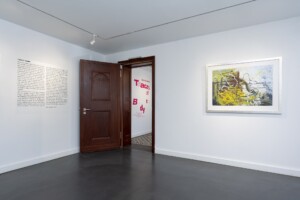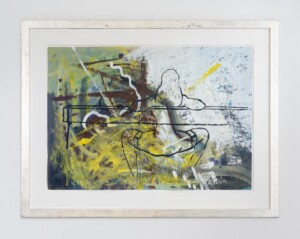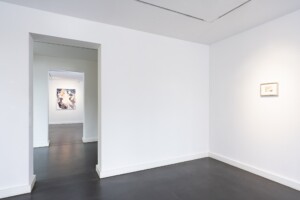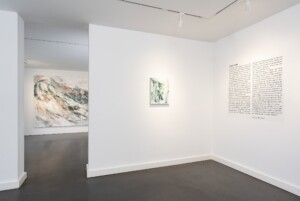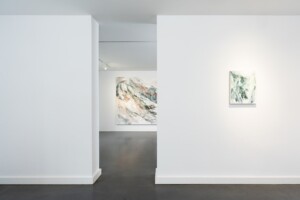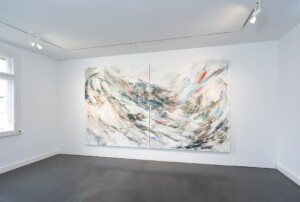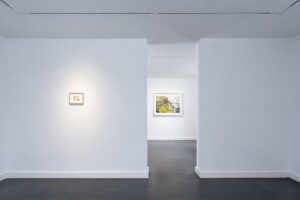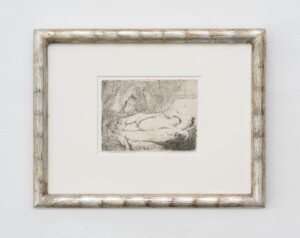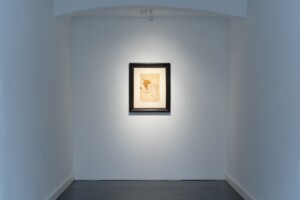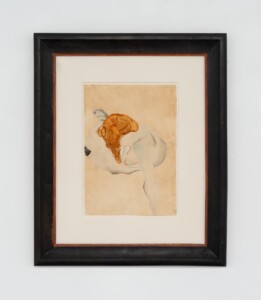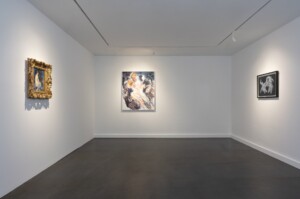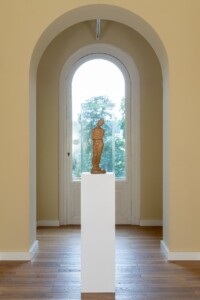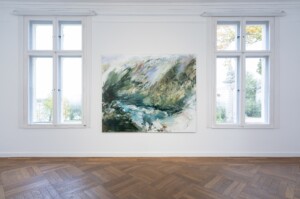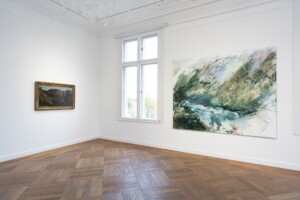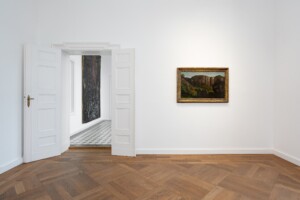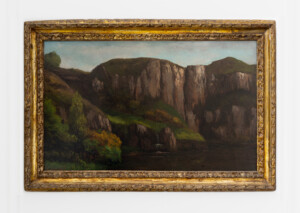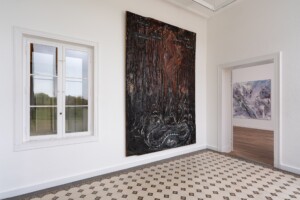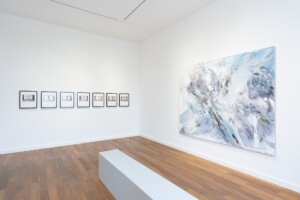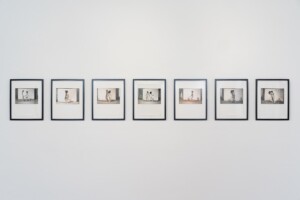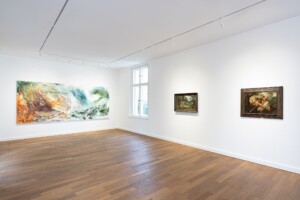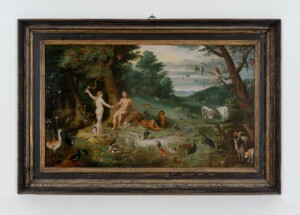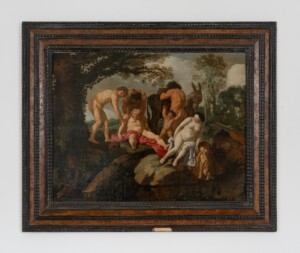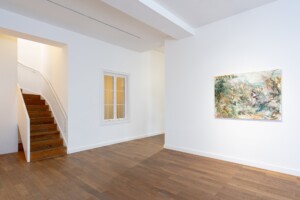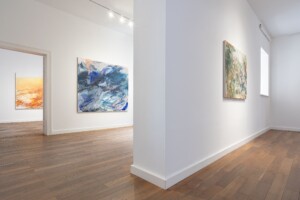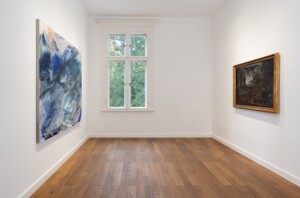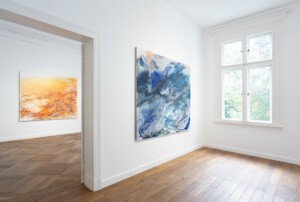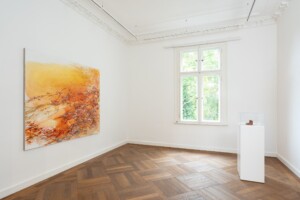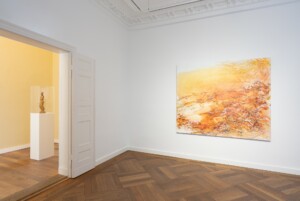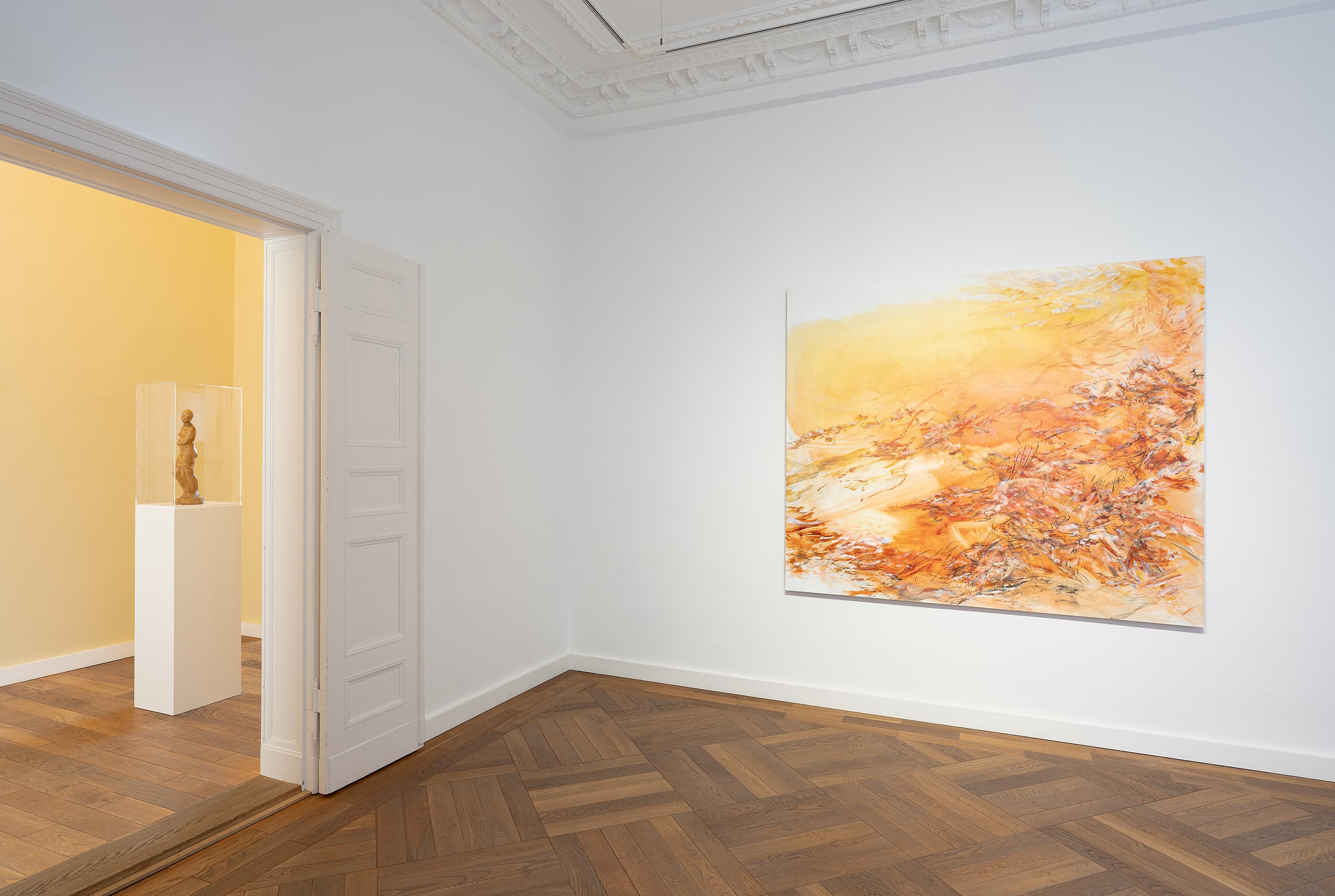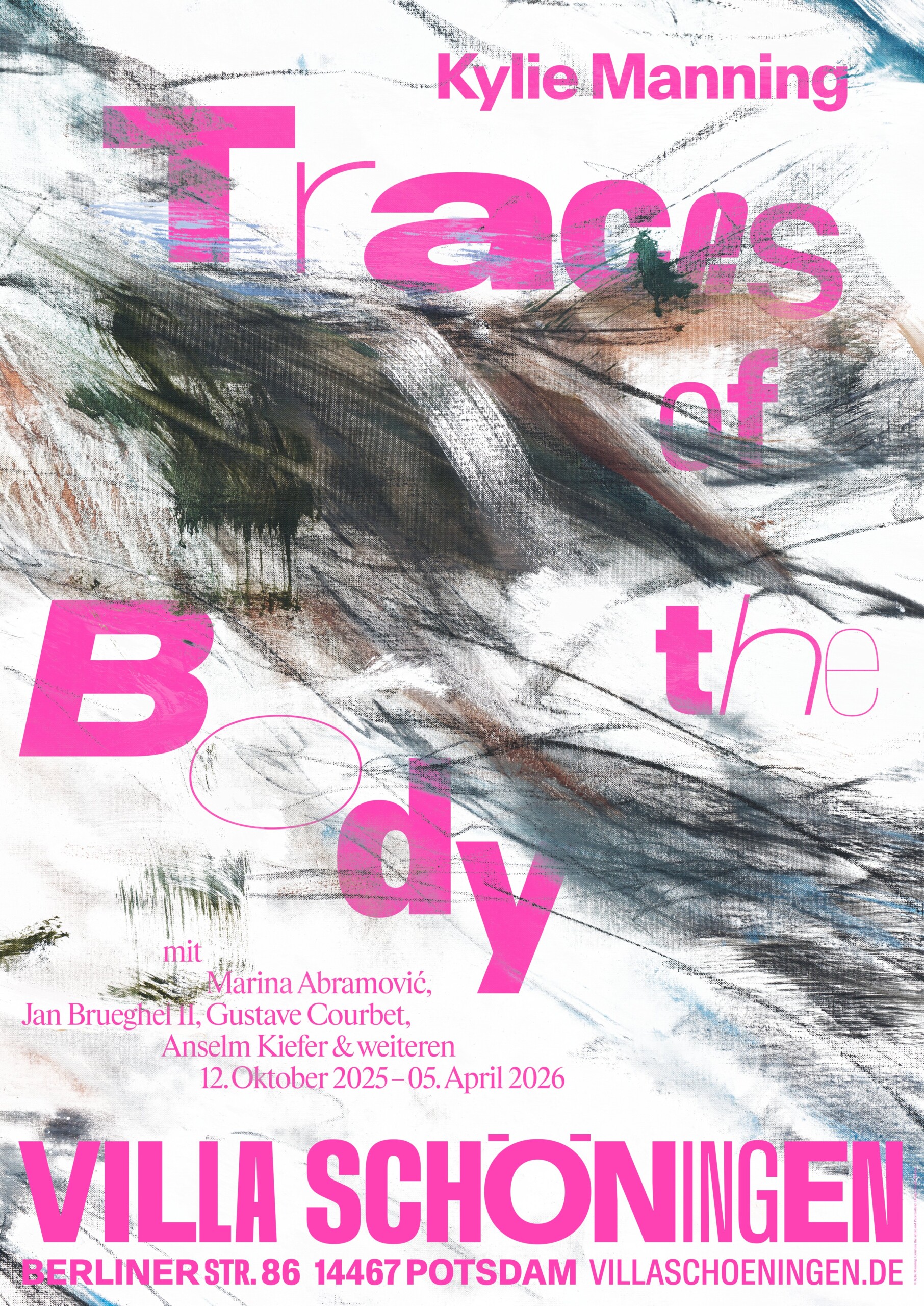Traces of the Body
We live in a time characterized by acceleration and fleeting moments. Encounters, images, and experiences appear and disappear rapidly. Sociologists describe this phenomenon as “social acceleration,” which is characterized by the constant intensification of the rhythms of work, communication, and perception. Transience is no longer the exception but a fundamental aspect of life.
In this context, the following questions arise: What remains when the permanent erodes, and how can the transitory be made visible? In a time when the media stages bodies, politics negotiates them, and the economy exploits them, what traces do they leave behind?
The paintings of US artist Kylie Manning (born in Juneau, Alaska, in 1983; currently living in Brooklyn) offer a poetic response. Her paintings, which are being shown comprehensively in Germany for the first time, move between figuration and abstraction. Bodies appear not as solid forms, but as suggestions. Light and movement are inscribed into multilayered surfaces that reveal an inner glow through glazing, sanding, and pigment application processes. Manning’s works seem like landscapes of memory: familiar yet distant, a fleeting presence in the moment of their disappearance.
Kylie Manning created most of her large-format works specifically for this exhibition. Her pieces deliberately correspond to select art-historical positions. They engage in dialogue with Jan Brueghel II, whose Baroque imagery attempted to organize the world; Wilhelm Lehmbruck, who depicted fragile bodies; and Marina Abramović and Ulay, as well as Anselm Kiefer, who treated the body as a process, trace, and memory. These correspondences open up a space of resonance in which questions of physicality, visibility, power, and gender intersect. The body is no longer perceived as a static form but as movement, trace, and transition.
Traces of the Body asks: How can we understand the fleeting – as loss or as possibility? Could the ephemeral offer a clearer view of the body, the moment, and ourselves?
Pola van den Hövel
 Sigmar Polke, Untitled, 1983, Acryl auf Papier/ Acrylic on paper © Villa Schöningen, Foto: Sascha Herrmann, 2025.
Sigmar Polke, Untitled, 1983, Acryl auf Papier/ Acrylic on paper © Villa Schöningen, Foto: Sascha Herrmann, 2025.
 Sigmar Polke, Untitled, 1983, Acryl auf Papier/ Acrylic on paper © Villa Schöningen, Foto: Sascha Herrmann, 2025.
Sigmar Polke, Untitled, 1983, Acryl auf Papier/ Acrylic on paper © Villa Schöningen, Foto: Sascha Herrmann, 2025.
 Kylie Manning, A state like fever 2025 Holzkohle, Graphit, Öl, Kupfer, Glimmer und Quarz auf Leinen/ Charcoal, graphite, oil, copper, mica and quartz on linen, Rembrandt van Rijn, Jupiter und Antiope, Um 1631/ Around 1631, Radierung und Kupferstich auf Bütten/ Etching and copperplate engraving on handmade paper © Villa Schöningen. Courtesy the artist and Pace Gallery. Foto: Sascha Herrmann, 2025.
Kylie Manning, A state like fever 2025 Holzkohle, Graphit, Öl, Kupfer, Glimmer und Quarz auf Leinen/ Charcoal, graphite, oil, copper, mica and quartz on linen, Rembrandt van Rijn, Jupiter und Antiope, Um 1631/ Around 1631, Radierung und Kupferstich auf Bütten/ Etching and copperplate engraving on handmade paper © Villa Schöningen. Courtesy the artist and Pace Gallery. Foto: Sascha Herrmann, 2025.
 Kylie Manning, To one who lives here, 2024-2025, Öl, Turmalin, Quarz, Graphit, Holzkohle auf Leinen/ Oil, tourmaline, quartz, graphite, charcoal on linen, Kylie Manning, Abruptly shifting sides, 2025, Holzkohle, Graphit, Öl, Metall-Oxid und Glimmer auf Leinen/ Charcoal, graphite, oil, meal oxide and mica on linen © Villa Schöningen, Courtesy the artist and Pace Gallery, Foto: Sascha Herrmann, 2025.
Kylie Manning, To one who lives here, 2024-2025, Öl, Turmalin, Quarz, Graphit, Holzkohle auf Leinen/ Oil, tourmaline, quartz, graphite, charcoal on linen, Kylie Manning, Abruptly shifting sides, 2025, Holzkohle, Graphit, Öl, Metall-Oxid und Glimmer auf Leinen/ Charcoal, graphite, oil, meal oxide and mica on linen © Villa Schöningen, Courtesy the artist and Pace Gallery, Foto: Sascha Herrmann, 2025.
 Kylie Manning, To one who lives here, 2024-2025, Öl, Turmalin, Quarz, Graphit, Holzkohle auf Leinen/ Oil, tourmaline, quartz, graphite, charcoal on linen, Kylie Manning, Abruptly shifting sides, 2025, Holzkohle, Graphit, Öl, Metall-Oxid und Glimmer auf Leinen/ Charcoal, graphite, oil, meal oxide and mica on linen © Villa Schöningen, Courtesy the artist and Pace Gallery, Foto: Sascha Herrmann, 2025.
Kylie Manning, To one who lives here, 2024-2025, Öl, Turmalin, Quarz, Graphit, Holzkohle auf Leinen/ Oil, tourmaline, quartz, graphite, charcoal on linen, Kylie Manning, Abruptly shifting sides, 2025, Holzkohle, Graphit, Öl, Metall-Oxid und Glimmer auf Leinen/ Charcoal, graphite, oil, meal oxide and mica on linen © Villa Schöningen, Courtesy the artist and Pace Gallery, Foto: Sascha Herrmann, 2025.
 Kylie Manning, To one who lives here, 2024-2025, Öl, Turmalin, Quarz, Graphit, Holzkohle auf Leinen/ Oil, tourmaline, quartz, graphite, charcoal on linen © Villa Schöningen, Courtesy the artist and Pace Gallery, Foto: Sascha Herrmann, 2025.
Kylie Manning, To one who lives here, 2024-2025, Öl, Turmalin, Quarz, Graphit, Holzkohle auf Leinen/ Oil, tourmaline, quartz, graphite, charcoal on linen © Villa Schöningen, Courtesy the artist and Pace Gallery, Foto: Sascha Herrmann, 2025.
 Rembrandt van Rijn, Jupiter und Antiope, Um 1631/ Around 1631, Radierung und Kupferstich auf Bütten/ Etching and copperplate engraving on handmade paper, Sigmar Polke, Untitled, 1983, Acryl auf Papier/ Acrylic on paper © Villa Schöningen, Foto: Sascha Herrmann, 2025.
Rembrandt van Rijn, Jupiter und Antiope, Um 1631/ Around 1631, Radierung und Kupferstich auf Bütten/ Etching and copperplate engraving on handmade paper, Sigmar Polke, Untitled, 1983, Acryl auf Papier/ Acrylic on paper © Villa Schöningen, Foto: Sascha Herrmann, 2025.
 Rembrandt van Rijn, Jupiter und Antiope, Um 1631/ Around 1631, Radierung und Kupferstich auf Büten/ Etching and copperplate engravin on handmade paper ©Villa Schöningen, Foto: Sascha Herrmann, 2025.
Rembrandt van Rijn, Jupiter und Antiope, Um 1631/ Around 1631, Radierung und Kupferstich auf Büten/ Etching and copperplate engravin on handmade paper ©Villa Schöningen, Foto: Sascha Herrmann, 2025.
 Egon Schiele, Weiblicher Akt auf ihren Arm gestützt, 1912, Gouache, Aquarell und Bleistift auf Papier/ Gouache, watercolor, and pencil on paper © Villa Schöningen, Foto: Sascha Herrmann, 2025.
Egon Schiele, Weiblicher Akt auf ihren Arm gestützt, 1912, Gouache, Aquarell und Bleistift auf Papier/ Gouache, watercolor, and pencil on paper © Villa Schöningen, Foto: Sascha Herrmann, 2025.
 Egon Schiele, Weiblicher Akt auf ihren Arm gestützt, 1912, Gouache, Aquarell und Bleistift auf Papier/ Gouache, watercolor, and pencil on paper © Villa Schöningen, Foto: Sascha Herrmann, 2025.
Egon Schiele, Weiblicher Akt auf ihren Arm gestützt, 1912, Gouache, Aquarell und Bleistift auf Papier/ Gouache, watercolor, and pencil on paper © Villa Schöningen, Foto: Sascha Herrmann, 2025.
 Pierre-Auguste Renoir, Baigneuse, 1876, Öl auf Leinwand/ Oil on Canva, Kylie Manning, A state like fever, 2025, Holzkohle, Graphit, Öl, Kupfer, Glimmer und Quarz auf Leinen/ Charcoal, graphite, oil, copper, mica and quartz on linen, Man Ray, Les Trois Nus, 1971, Siebdruck auf Acrylglas/ Silkscreen on acrylic glass ©Villa Schöningen, Foto: Sascha Herrmann, 2025
Pierre-Auguste Renoir, Baigneuse, 1876, Öl auf Leinwand/ Oil on Canva, Kylie Manning, A state like fever, 2025, Holzkohle, Graphit, Öl, Kupfer, Glimmer und Quarz auf Leinen/ Charcoal, graphite, oil, copper, mica and quartz on linen, Man Ray, Les Trois Nus, 1971, Siebdruck auf Acrylglas/ Silkscreen on acrylic glass ©Villa Schöningen, Foto: Sascha Herrmann, 2025
 Wilhelm Lehmbruck, Kleine Sinnende, 1910/11, Gips, Ocker getönt, mit Schellack/ Plaster, ochre tinted, with shellac © Villa Schöningen, Foto: Sascha Herrmann, 2025.
Wilhelm Lehmbruck, Kleine Sinnende, 1910/11, Gips, Ocker getönt, mit Schellack/ Plaster, ochre tinted, with shellac © Villa Schöningen, Foto: Sascha Herrmann, 2025.
 Kylie Manning, Being and going on being, 2025, Holzkohle, Graphit, Öl und Quarz auf Leinen/ Charcoal, graphite, oil and quartz on linen ©Villa Schöningen, Foto: Sascha Herrmann, 2025
Kylie Manning, Being and going on being, 2025, Holzkohle, Graphit, Öl und Quarz auf Leinen/ Charcoal, graphite, oil and quartz on linen ©Villa Schöningen, Foto: Sascha Herrmann, 2025
 Gustave Courbet, Les rochers de Bonnevaux, 1866 oder/ or 1872 Öl auf Leinwand/ Oil on canvas, Kylie Manning, Being and going on being, 2025, Holzkohle, Graphit, Öl und Quarz auf Leinen/ Charcoal, graphite, oil and quartz on linen ©Villa Schöningen, Foto: Sascha Herrmann, 2025
Gustave Courbet, Les rochers de Bonnevaux, 1866 oder/ or 1872 Öl auf Leinwand/ Oil on canvas, Kylie Manning, Being and going on being, 2025, Holzkohle, Graphit, Öl und Quarz auf Leinen/ Charcoal, graphite, oil and quartz on linen ©Villa Schöningen, Foto: Sascha Herrmann, 2025
 Anselm Kiefer, Maria, 1977, Öl auf Leinwand/ Oil on canvas, Gustave Courbet, Les rochers de Bonnevaux 1866 oder/ or 1872, Öl auf Leinwand/ Oil on canvas © Villa Schöningen, Foto: Sascha Herrmann, 2025.
Anselm Kiefer, Maria, 1977, Öl auf Leinwand/ Oil on canvas, Gustave Courbet, Les rochers de Bonnevaux 1866 oder/ or 1872, Öl auf Leinwand/ Oil on canvas © Villa Schöningen, Foto: Sascha Herrmann, 2025.
 Gustave Courbet, Les rochers de Bonnevaux, 1866 oder/ or 1872, Öl auf Leinwand © Villa Schöningen, Foto: Sascha Herrmann, 2025.
Gustave Courbet, Les rochers de Bonnevaux, 1866 oder/ or 1872, Öl auf Leinwand © Villa Schöningen, Foto: Sascha Herrmann, 2025.
 Anselm Kiefer, Maria, 1977, Öl auf Leinwand/ Oil on canvas, Kylie Manning, Shutting the eyelids down tight, 2025, Holzkohle, Graphit, Öl, Metall-Oxid, Glimmer und Quarz auf Leinen/ Charcoal, graphite, oil, metal oxide, mica and quartz on linen © Villa Schöningen, Foto: Sascha Herrmann, 2025.
Anselm Kiefer, Maria, 1977, Öl auf Leinwand/ Oil on canvas, Kylie Manning, Shutting the eyelids down tight, 2025, Holzkohle, Graphit, Öl, Metall-Oxid, Glimmer und Quarz auf Leinen/ Charcoal, graphite, oil, metal oxide, mica and quartz on linen © Villa Schöningen, Foto: Sascha Herrmann, 2025.
 Marina Abramovic und Ulay, Relation in Space, Aufgeführt/ Performed 1976 Veröffentlicht/ published 1977, Gelatine Silber Druck, in sieben Teilen/ Gelatin silver print, in seven parts, Kylie Manning, Shutting the eyelids down tight, 2025, Holzkohle, Graphit, Öl, Metall-Oxid, Glimmer und Quarz auf Leinen/ Charcoal, graphite, oil, metal oxide, mica and quartz on linen © Villa Schöningen, Foto: Sascha Herrmann, 2025.
Marina Abramovic und Ulay, Relation in Space, Aufgeführt/ Performed 1976 Veröffentlicht/ published 1977, Gelatine Silber Druck, in sieben Teilen/ Gelatin silver print, in seven parts, Kylie Manning, Shutting the eyelids down tight, 2025, Holzkohle, Graphit, Öl, Metall-Oxid, Glimmer und Quarz auf Leinen/ Charcoal, graphite, oil, metal oxide, mica and quartz on linen © Villa Schöningen, Foto: Sascha Herrmann, 2025.
 Marina Abramovic und Ulay, Relation in Space, Aufgeführt/ Performed 1976 Veröffentlicht/ published 1977, Gelatine Silber Druck, in sieben Teilen/ Gelatin silver print, in seven parts © Villa Schöningen, Foto: Sascha Herrmann, 2025.
Marina Abramovic und Ulay, Relation in Space, Aufgeführt/ Performed 1976 Veröffentlicht/ published 1977, Gelatine Silber Druck, in sieben Teilen/ Gelatin silver print, in seven parts © Villa Schöningen, Foto: Sascha Herrmann, 2025.
 Kylie Manning, The weight of the seas, 2025, Holzkohle, Graphit, Öl, Turmalin und Quarz auf Leinen/ Charcoal, graphite, oil, turmaline and quartz on linen, Jan Brueghel II, Paradieslandschaft mit dem Sündenfall, 16. Jahrhundert, Öl auf Holzplatte/ Oil on wood, Moyses van Uyttenbroek, Der trunkene Silen mit den phrygischen Bauern, Ohne Jahresangabe/ Without year, Öl auf Holz/ Oil on wood © Villa Schöningen, Foto: Sascha Herrmann, 2025.
Kylie Manning, The weight of the seas, 2025, Holzkohle, Graphit, Öl, Turmalin und Quarz auf Leinen/ Charcoal, graphite, oil, turmaline and quartz on linen, Jan Brueghel II, Paradieslandschaft mit dem Sündenfall, 16. Jahrhundert, Öl auf Holzplatte/ Oil on wood, Moyses van Uyttenbroek, Der trunkene Silen mit den phrygischen Bauern, Ohne Jahresangabe/ Without year, Öl auf Holz/ Oil on wood © Villa Schöningen, Foto: Sascha Herrmann, 2025.
 Jan Brueghel II, Paradieslandschaft mit dem Sündenfall, 16. Jahrhundert, Öl auf Holzplatte/ Oil on wood © Villa Schöningen, Foto: Sascha Herrmann, 2025.
Jan Brueghel II, Paradieslandschaft mit dem Sündenfall, 16. Jahrhundert, Öl auf Holzplatte/ Oil on wood © Villa Schöningen, Foto: Sascha Herrmann, 2025.
 Moyses van Uyttenbroek, Der trunkene Silen mit den phrygischen Bauern, Ohne Jahresangabe/ Without year, Öl auf Holz/ Oil on wood © Villa Schöningen, Foto: Sascha Herrmann, 2025.
Moyses van Uyttenbroek, Der trunkene Silen mit den phrygischen Bauern, Ohne Jahresangabe/ Without year, Öl auf Holz/ Oil on wood © Villa Schöningen, Foto: Sascha Herrmann, 2025.
 Kylie Manning, Daybreak, 2025, Holzkohle, Graphit, Öl, Kupfer, Glimmer und Quarz auf Leinen/ Charcoal, graphite, oil, copper, mica and quartz on linen © Villa Schöningen, Foto: Sascha Herrmann, 2025.
Kylie Manning, Daybreak, 2025, Holzkohle, Graphit, Öl, Kupfer, Glimmer und Quarz auf Leinen/ Charcoal, graphite, oil, copper, mica and quartz on linen © Villa Schöningen, Foto: Sascha Herrmann, 2025.
 Kylie Manning, Cicadas, 2025, Holzkohle, Graphit, Öl, Kupfer, Glimmer und Quarz auf Leinen/ Charcoal, graphite, oil, copper, mica and quartz on linen, Kylie Manning, Years and years before, 2025, Holzkohle, Graphit, Öl, Metall-Oxide, Glimmer und Quarz auf Leinen/ Charcoal, graphite, oil, metal oxide, mica and quartz on linen, Kylie Manning, Daybreak, 2025, Holzkohle, Graphit, Öl, Kupfer, Glimmer und Quarz auf Leinen/ Charcoal, graphite, oil, copper, mica and quartz on linen ©Villa Schöningen, Foto: Sascha Herrmann, 2025
Kylie Manning, Cicadas, 2025, Holzkohle, Graphit, Öl, Kupfer, Glimmer und Quarz auf Leinen/ Charcoal, graphite, oil, copper, mica and quartz on linen, Kylie Manning, Years and years before, 2025, Holzkohle, Graphit, Öl, Metall-Oxide, Glimmer und Quarz auf Leinen/ Charcoal, graphite, oil, metal oxide, mica and quartz on linen, Kylie Manning, Daybreak, 2025, Holzkohle, Graphit, Öl, Kupfer, Glimmer und Quarz auf Leinen/ Charcoal, graphite, oil, copper, mica and quartz on linen ©Villa Schöningen, Foto: Sascha Herrmann, 2025
 Kylie Manning, Years and years before, 2025, Holzkohle, Graphit, Öl, Metall-Oxide, Glimmer und Quarz auf Leinen/ Charcoal, graphite, oil, metal oxide, mica and quartz on linen, Jacob Isaacsz. van Swanenburgh, Die Versuchung des Heiligen Antonius, Ohne Jahresangabe/ Without year, Öl auf Leinwand (doubliert)/ Oil on canvas (doubled) © Villa Schöningen, Foto: Sascha Herrmann, 2025.
Kylie Manning, Years and years before, 2025, Holzkohle, Graphit, Öl, Metall-Oxide, Glimmer und Quarz auf Leinen/ Charcoal, graphite, oil, metal oxide, mica and quartz on linen, Jacob Isaacsz. van Swanenburgh, Die Versuchung des Heiligen Antonius, Ohne Jahresangabe/ Without year, Öl auf Leinwand (doubliert)/ Oil on canvas (doubled) © Villa Schöningen, Foto: Sascha Herrmann, 2025.
 Kylie Manning, Cicadas, 2025, Holzkohle, Graphit, Öl, Kupfer, Glimmer und Quarz auf Leinen/ Charcoal, graphite, oil, copper, mica and quartz on linen, Kylie Manning, Years and years before, 2025, Holzkohle, Graphit, Öl, Metall-Oxide, Glimmer und Quarz auf Leinen/ Charcoal, graphite, oil, metal oxide, mica and quartz on linen, ©Villa Schöningen, Foto: Sascha Herrmann, 2025
Kylie Manning, Cicadas, 2025, Holzkohle, Graphit, Öl, Kupfer, Glimmer und Quarz auf Leinen/ Charcoal, graphite, oil, copper, mica and quartz on linen, Kylie Manning, Years and years before, 2025, Holzkohle, Graphit, Öl, Metall-Oxide, Glimmer und Quarz auf Leinen/ Charcoal, graphite, oil, metal oxide, mica and quartz on linen, ©Villa Schöningen, Foto: Sascha Herrmann, 2025
 Kylie Manning, Cicadas, 2025, Holzkohle, Graphit, Öl, Kupfer, Glimmer und Quarz auf Leinen/ Charcoal, graphite, oil, copper, mica and quartz on linen, Marcel Duchamp, Feuille de vigne femelle, 1950, Gestrichener Putz/ Painted plaster © Villa Schöningen, Foto: Sascha Herrmann, 2025.
Kylie Manning, Cicadas, 2025, Holzkohle, Graphit, Öl, Kupfer, Glimmer und Quarz auf Leinen/ Charcoal, graphite, oil, copper, mica and quartz on linen, Marcel Duchamp, Feuille de vigne femelle, 1950, Gestrichener Putz/ Painted plaster © Villa Schöningen, Foto: Sascha Herrmann, 2025.
 Marcel Duchamp, Feuille de vigne femelle, 1950, Gestrichener Putz/ Painted plaster, Kylie Manning, Cicadas, 2025, Holzkohle, Graphit, Öl, Kupfer, Glimmer und Quarz auf Leinen/ Charcoal, graphite, oil, copper, mica and quartz on linen ©Villa Schöningen, Foto: Sascha Herrmann, 2025
Marcel Duchamp, Feuille de vigne femelle, 1950, Gestrichener Putz/ Painted plaster, Kylie Manning, Cicadas, 2025, Holzkohle, Graphit, Öl, Kupfer, Glimmer und Quarz auf Leinen/ Charcoal, graphite, oil, copper, mica and quartz on linen ©Villa Schöningen, Foto: Sascha Herrmann, 2025
